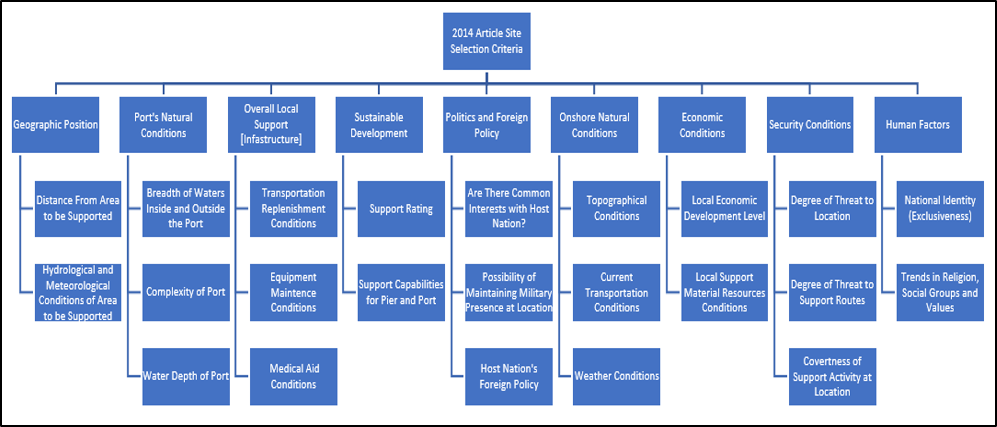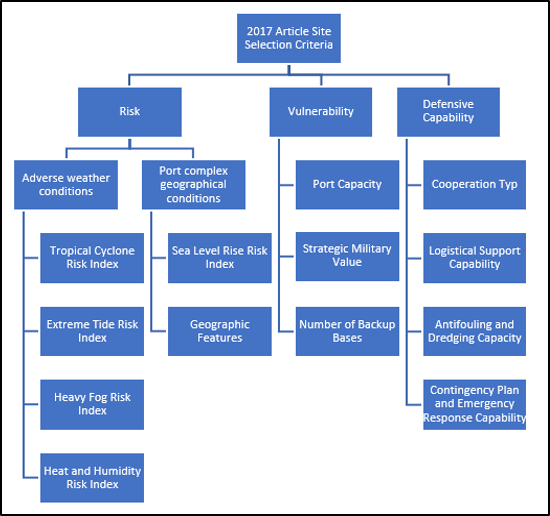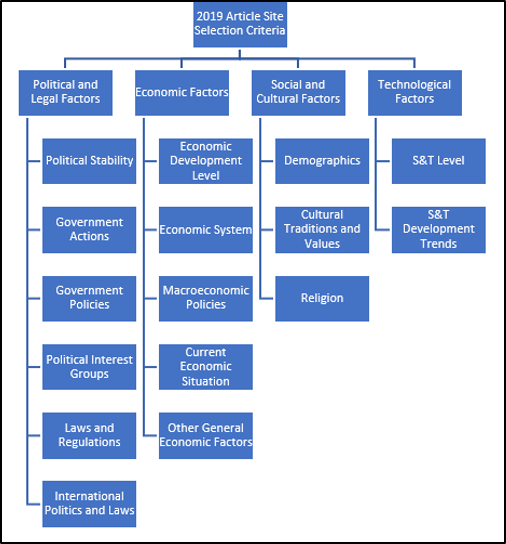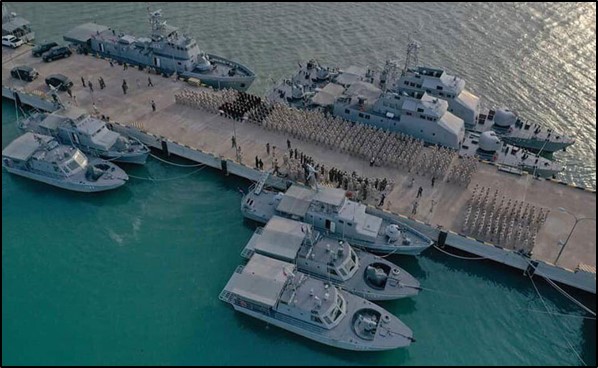Introduction
Since the People’s Republic of China (PRC) established its first official overseas military base in Djibouti in 2017, there has been much speculation about where China’s next base will be. Chinese military authors have themselves shown considerable interest in this issue, discussing the value of potential overseas “strategic strong points” (战略支点, zhanlüe zhidian) for use by People’s Liberation Army (PLA) forces (China Brief, March 22, 2019). The Department of Defense’s 2020 annual report on the Chinese military indicates that “Beyond its current base in Djibouti, the PRC is very likely already considering and planning for additional overseas military logistics facilities to support naval, air, and ground forces”. The report lists a broad range of countries that China “has likely considered,” which include: “Myanmar, Thailand, Singapore, Indonesia, Pakistan, Sri Lanka, United Arab Emirates, Kenya, Seychelles, Tanzania, Angola, and Tajikistan” (Department of Defense, September 1, 2020).
Rumors in the Western media touch on an even greater variety of locations. Cambodia has received the most attention, with reports in July 2019 indicating that an agreement had been finalized for a Chinese PLA Navy (PLAN) base at the existing Ream port facility (China Brief, August 14, 2019). The U.S. Defense Intelligence Agency has also pointed to Pakistan as a leading contender for another location (Department of Defense, January 14, 2019). However, these conversations have overlooked one central question: how does the Chinese military itself think about selecting the locations for its overseas military bases?
Drivers of PLA Basing Abroad
As China’s national interests expand outside its national boundaries, the PLA has been increasingly called upon to protect those interests abroad. Hu Jintao’s 2004 call for the PLA to shoulder “New Historic Missions” ushered in this new era, but Xi Jinping has taken it to the next level by declaring that China’s interests are now global under the framework of the Belt and Road Initiative (BRI) and the “community for a shared future for mankind.” Xi expects the PLA to more fully support this expansion. In his 2017 speech to the 19th Party Congress, Xi called for the PLA to become a “world class military” by 2050 and said that the CCP “must do more to safeguard China’s sovereignty, security, and development interests” (China Daily, October 18, 2017). The PRC’s 2019 defense white paper explains that the PLA is tasked with “safeguard[ing] China’s overseas interests,” and explicitly states that the PLA will “[develop] overseas logistical facilities.” It also identified some of the PLA’s specific overseas missions that these bases will support, including “vessel protection operations, maintain[ing] the security of strategic sea lines of communications (SLOCs), and carr[ying] out overseas evacuation and maritime rights protection operations” (Xinhua, July 24, 2019).
Beyond Asia, it is clear that the PLA’s initial area of focus is securing the SLOCs from the Middle East through the Indian Ocean that provide the majority of China’s energy imports and maritime commerce (National Defense University, January 22). Thus it is not a surprise that China’s first long-term foreign deployment was the Gulf of Aden counter-piracy task force (beginning in 2008) and that its first base was established in Djibouti. Ultimately, China’s decisions on the future locations of Chinese military bases abroad will be made by the Chinese leadership—Xi Jinping first and foremost—based on diplomatic opportunity and broader strategic requirements. It is also important to consider that some, if not most, of the PLA’s peacetime operational requirements may be fulfilled by dual-use commercial ports. However, PRC researchers have identified a number of complex criteria to consider in selecting overseas bases, as detailed further below.
Future Overseas Military Base Site Selection Considerations
PLA researchers assess potential locations for overseas military bases across a variety of economic, political, cultural, environmental, and physical infrastructure factors. Three recent articles illustrate PLA thinking on the topic: a 2014 article by professors at the PLA Navy’s Dalian Naval Academy (hereafter cited in-text as Dalian Naval Academy, 2014); a 2017 article by a professor and graduate students at the National University of Defense Technology (NUDT) (hereafter cited in-text as NUDT, 2017); and a 2019 article by a professor and graduate students at the PLAN’s Naval University of Engineering in Wuhan (hereafter cited in-text as PLAN University of Engineering, 2019).[1] While none of the articles is singularly authoritative, their publication clearly indicates that the topic is no longer taboo—and reaffirms the widely held assumption that the PLA is planning for more overseas bases.
Figure 1: 2014 Article Site Selection Criteria
 Source: Compiled by the author.
Source: Compiled by the author.The 2014 article proposed a mixed methods analytic approach for assessing the suitability of potential base locations, incorporating both “objective” quantitative data and “subjective” qualitative data in the form of an experts committee (Dalian Naval Academy, 2014). The authors framed overseas bases as necessary for SLOC protection in the face of global instability, and argue that bases will display the PLAN’s strategic position, support distant sea operations, strengthen bilateral relations with the host nation, and influence regional strategic balance. They identify nine categories and 23 factors for consideration, supposedly centered on utility and timeliness for the military (see accompanying Figure 1).
The 2014 authors conducted a case study of an undisclosed location to test their methodology, using a 10-person expert committee and a set of quantitative data that was not clearly delineated. The authors excluded three criteria either because they didn’t impact the scores (port complexity) or because they overlapped with other criteria (host nation foreign policy and level of threat to the location). The unnamed location scored best on whether it would allow a military presence (even though it scored poor on foreign policy), economic development level, and having a low threat to support routes. It would be a logical assumption that Djibouti was the subject of this case study, but this cannot be determined with certainty.
The 2017 article sought to assess environmental risks (mainly climate change) to potential overseas base locations by utilizing a similar mixed methods approach and Bayesian network analysis to create a composite weighted score (NUDT, 2017).[2] The article frames overseas military bases as a “bridgehead” (桥头堡, qiaotoubao) for China’s opening to the world through the BRI, and asserts that bases can have an “important impact on China’s ability to project power and expand its overseas interests,” with attendant political and diplomatic functions. The researchers assessed 13 factors across three main categories: risk, vulnerability, and defensive capability (see accompanying Figure 2).
Figure 2. 2017 Article Site Selection Criteria
 Source: Compiled by the author.
Source: Compiled by the author.From the perspective of environmental risk, the authors assert that adverse weather is the biggest threat— especially tropical cyclones in the summer months—and they even include consideration of hot weather’s negative impact on troops’ mental well-being. The framework employed quantitative data for most of the criteria, but also used an expert committee to provide a modicum of quantitative assessment on qualitative questions such as strategic military value. While risk factors as a whole weighed heavily in the final evaluation score, the two individual criteria that weighed most heavily—and were thus the most important—were the base’s geographic characteristics (e.g., “high elevation above sea level, flat terrain, good vegetation conditions”) and its strategic military value (e.g., whether it is a strategic strongpoint, normal base, or backup base). Additionally, some criteria may reflect other considerations beyond those mentioned: port capacity is framed as a way to measure economic activity, but could also be used to measure the port’s throughput capacity for military force flow.
The article centered on a case study for an unnamed location, which appeared almost certainly to be Djibouti. This assumption is based on its assertion that the PLAN had a “pressing need” for a base to provide logistics support for the Gulf of Aden escort operations; its explicit claim that the location is near the Gulf of Aden; the time the article was written (late 2016); its use of meteorological data from the Indian government for the Indian Ocean region; and its reference to the base’s value as a “strategic strongpoint.” Assuming that it is indeed Djibouti, this case study thus provides some insights into how at least one group of PLA researchers assessed China’s first overseas base as a baseline for future locations. The base was assessed to have good geographic conditions, high strategic military value, an average “cooperation type” (likely meaning joint management of the base location between the host nation and visiting nation personnel), and a strong emergency response capability; but a low-to-moderate logistics support capability, low port capacity, and a high risk for sea level rise. This analysis suggests that Djibouti was selected more for the strategic value of its geographic location than for its ability to truly support PLA missions.
Figure 3. 2019 Article Site Selection Criteria
 Source: Compiled by the author.
Source: Compiled by the author.The 2019 article is more explicit about the objectives of China’s growing overseas military presence, linking it with the BRI, the PLA’s “going out” strategy, and the PLAN’s new service strategy of “near seas defense, far seas protection, oceanic presence, and expansion into the two poles” (PLAN University of Engineering, 2019). [3] The authors framed bases as providing effective and immediate logistics support for overseas operations, in order to improve the PLAN’s overseas combat capability and support security for overseas interests. They also argued that it is a way to “actively advance” China’s national development in peacetime, and assert that “in the foreseeable future, basing at overseas Chinese bases will also become normalized.”
The 2019 authors proposed a qualitative approach to evaluate potential locations, based on four categories and 16 factors centered around a “PEST” framework: political, economic, social and technological. The 2019 article ran the authors’ framework through two case studies: U.S. basing access in Singapore, and the Chinese base in Djibouti. For Djibouti’s politics, the authors explained that the country has long been politically stable; and that, because it is a poor country that needs the extra revenue, it has domestic laws that allow foreign bases. Economically, its poverty may make procurement difficult (for unstated reasons). Socially, China’s foreign aid gives China a good international image that earns the local population’s support; this should reduce any negative cultural impacts. Technologically, Djibouti’s natural deep-water port should be able to support PLAN vessels as they become larger in size.
Considerations of Logistics Support in Base Location Selection
The presence of Chinese companies at these locations is one factor that is not explicitly considered but appears to be an important implicit consideration. Perhaps surprisingly, their presence is not treated as a one-size-fits-all solution: the 2019 article noted that, although one of the PLA’s existing procurement models for replenishment without bases is to leverage Chinese companies overseas, “since their main responsibility is certainly not replenishing the Chinese military overseas, procurement channels are limited” (PLAN University of Engineering, 2019). The benefit of their “long-term presence,” is that it “may largely mitigate the political impacts of PLA direct purchases of logistic supplies”—thereby suggesting that Chinese companies would simply act as middlemen for replenishment if bases were established. A separate July 2019 article (discussed below and hereafter cited in-text as Military Transportation University, 2019) similarly predicted that Chinese companies would play a go-between role to provide supplies to the PLA in wartime. [4]
Another implicit factor, at least for some Chinese analysts, may be a location’s ability to host wartime pre-positioned materials (战备物资储备, zhanbei wuci chubei -or- 预置储备, yuzhi chubei) for the PLA. A July 2019 article argued that bases enable more immediate and reliable support to improve the PLA’s distant sea combat capability, and that China will eventually need more bases abroad with pre-positioned material (Military Transportation University, 2019). [5] The article presented three options for how to use overseas military bases for this purpose. First, the base can host the material onsite in a storage warehouse. Second, the PLA can cooperate with Chinese companies drawn abroad by the BRI to leverage their local knowledge and connections, such as signing a cooperation agreement with national oil companies to ensure oil in wartime to sustain operations; or allowing “local forces” to provide non-military support like medical services, cleaning, and food. Third, the military can cooperate with the local government by either renting storage space and directly purchasing material as necessary, or even creating a joint reserve.
The article explicitly assumes that Chinese diplomacy will allow the PLA to dictate the size and scope of the in-country storage and to maintain wartime access, thereby relieving the base of space pressure and saving transportation money. This aligns with a growing body of PLA research on both pre-positioned material in general, and especially abroad, that is drawn in part from observing the practices of U.S. forces. [6] Of note, the July 2019 article noted that the United States has materiel for two army divisions in Europe, among others; and that China’s base in Djibouti already hosts such pre-positioned material onsite in storage facilities. This suggests that this discussion is very operationally focused toward combat missions, and not for military operations other than war (MOOTW) such as noncombatant evacuation operations (NEO) (Military Transportation University, 2019).
Ignoring Inconvenient Issues and Missing Stakeholders
These articles ignore a number of significant challenges the PLA will face as it tries to build up a series of overseas bases. They do not address the risk that host countries will limit the scope of Chinese operations in wartime. Indeed, the 2017 article posited that one possible model of base access would be that the host nation would control the base in peacetime, whereas the visiting nation (i.e., China) would use the base during a crisis (or presumably wartime) (NUDT, 2017). The 2014 and 2019 articles also both considered “values” and culture a positive trait for Chinese engagement, even as the 2019 article raised culturally sensitive matters such as obtaining pork in Muslim countries. The most recent 2019 article doesn’t mention the issue of denials and backtracking by potential host countries—such as Cambodia’s fervent denials that it will host a Chinese naval base (Reuters, July 21, 2019).
These three studies appear to reflect distinct and separate research efforts among different PLA institutions. In one sense, this overlap shows that the PLA is clearly interested in the topic, and many organizations are likely responding to a central demand for analysis. In another sense, it reveals the fragmented nature of the PLA system. Despite what outsiders may assume to be a well-coordinated bureaucracy, these studies did not cite each other—despite being conducted over just a few years, and doing extensive literature reviews of their own niche topics.
Lastly, the lack of relevant writings by the PLA Army, Air Force, or Marine Corps suggests that the PLAN has taken the lead so far on overseas basing. Acknowledging this, one PLAAF researcher asserted that “the PLA has not yet established any overseas air transportation support bases (境外航空运输保障基地, jingwai hangkong yunshu baozhang jidi) due to geopolitical sensitives and a lack of demand for projection,” and that this is becoming a “bottleneck problem” limiting the PLA’s strategic power projection overseas. [7] This is similar to a complaint in the 2009 book Strategic Air Force that “relevant countries and relevant domestic departments are ‘not used’ to the Air Force departing the border, and categorically see it as a threat and provocation.” [8] Yet just as the PLAAF has now fully embraced operations outside Chinese territory, the construction of a bomber-length “civilian” runway next to the PRC’s likely future military base in Cambodia suggests the PLAAF may eventually be based, or at least have a regular presence, outside the country as well (NYT, December 22, 2019).
Conclusion
The growing body of PLA literature on overseas basing presents an opportunity to better understand PRC planning for overseas operations and long-term military presence outside China’s borders. In one sense, the ultimate location of future Chinese bases is simply dependent on other countries’ political will to host Chinese forces. However, where the PRC decides to pursue bases will be a more complicated calculus dependent on a number of factors: where the PLA wants to base itself, where Beijing thinks its forces will be welcomed, and where countries perhaps feel they have little recourse to reject a Chinese military presence. [9] Understanding how the PLA decides upon its desired base locations will be one component of limiting the expansion of the Chinese military abroad.
The author would like to thank Kristen Gunness and Isaac Kardon for their feedback on earlier drafts.
Nathan Beauchamp-Mustafaga is a Policy Analyst at the nonprofit and nonpartisan RAND Corporation.
Notes
[1] In order, see: Ma Liang [马良], Zhang Lin [张林] and Liu Xinke [刘新科], “Overseas Security Method of Assessing Point Location Based on Rough and Evidence Reasons. Bases” [“基于粗集和证据推理的海外基地保障点选址评估”], Command Control & Simulation [指挥控制与仿真] 36:1, February 2014, pp. 88-93; Jiang Deliang [姜德良], Zhang Ren [张韧] and Ge Shanshan [葛珊珊], “Natural Risk Scenario Simulation Assessment of Overseas Support Bases Based on Uncertain Knowledge” [“知识不确定条件下的海外保障基地 自然风险情景模拟评估”], Marine Science Bulletin [海洋通报] 36:5, October 2017, pp. 504-511, 537; Luo Zhaohui [罗朝晖], Wan Jie [万捷] and Li Hongyang [李弘扬], “Research on Factors in Site Selection of Overseas Military Base of Chinese Navy” [“我国海军海外基地选址因素研究”], Logistics Technology [物流技术], 2019, pp. 141-144.
[2] The authors have applied a similar framework to assess the risk of climate change on China’s domestic satellite launch sites. See: Song Chenyang [宋晨阳], Zhang Ren [张韧], and Xu Zeshui [徐泽水], “Safety Risk Analysis and Assessment of Climate Change on Satellite Bases” [“气候变化对中国卫星发射基地安全的影响与风险评估”], Military Operations Research and Systems Engineering [军事运筹与系统工程], April 2018.
[3] For more on this, see: Ryan Martinson, “The Role of the Arctic in Chinese Naval Strategy,” China Brief, December 20, 2019, https://jamestown.org/program/the-role-of-the-arctic-in-chinese-naval-strategy/.
[4] Li Shougeng [李守耕], Chen Tieqi [陈铁祺], Wang Feng [王丰],“On Preset Reserve Mode for Combat Readiness Material” [“战备物资预置储备模式研究”], Journal of Military Transportation University [军事交通学院学报], July 2019, pp. 57-60, 70.
[5] Also called “物资储备” or “预置预储” or “战储” (or in this case “海外战储”).
[6] For other PLA writings on overseas basing and pre-positioned material, see: Jiang Deliang [姜德良], Zhang Ren [张韧] and Ge Shanshan [葛珊珊], “Natural Risk Scenario Simulation Assessment of Overseas Support Bases Based on Uncertain Knowledge” [“知识不确定条件下的海外保障基地 自然风险情景模拟评估”], Marine Science Bulletin [海洋通报] 36:5, October 2017, pp. 504-511, 537; Liang Feng [梁峰], Gan Ming [甘明], and Wang Feng [王丰], “Overseas War Readiness Materials Reserve Mode in US Army and Enlightenment” [“美军海外战备物资储备模式及启示”], Journal of Military Transportation University [军事交通学院学报], November 2017; Wu Jiaxi [吴佳熹] and Liu Shenghan [刘晟含], “A Study on the Stockpiling Layout of War Reserve Materiel Based on Military-Civilian Integration” [“军民融合战备物资储备布局研究”], National Defense [国防], January 2018; Liang Feng [梁峰], Li Zhengshuo [李政硕], Zong Fuxing [宗福兴], Yu Li [于力], and Huang Binghao [黄炳豪], “Construction of Maritime Preposition Capability of Our Army” [“关于我军海上预置能力建设的思考”], Journal of Military Transportation University [军事交通学院学报], June 2018; Wang Jun [汪军] and Luo Chuancai [罗传才], “Some Thoughts on How to Accelerate the Building of a Powerful Modernized Logistics System” [“关于加快建设强大的现代化后勤的思考”], National Defense [国防], July 2018; Wang Feng [王丰], Jiang Ning [蒋宁], Xiong Zhenwei [熊振伟] and Huang Binghao [黄炳豪], “The Development Direction of Military Logistics in the New Period” [“新时期军事物流的发展方向”], Packaging Engineering [包装工程], July 2018; Zhou Fujiang [周辅疆], Luo Congwen [罗从文], Liu Yuan [刘源], “Construction of Handling Support Team in Civilian Ports for Maritime Joint Projection” [“海上联合投送民用港口装卸保障队伍建设”], Journal of Military Transportation University [军事交通学院学报], April 2019; Wang Guo [王果], Wang Zhibin [王志斌], Liu Jingqiao [刘靖峤], Weng Huanying [翁欢英], “Research of Amphibious Logistics Service” [“两栖登陆作战后勤保障研究”], Ship & Boat [船舶], April 2019. For lessons learned from the U.S. military, see: Tan Xiaolong [谭小龙] and Yuan Jinguo [袁金国], “Grasp several points in the reform of military organization” [“把握军队组织编制改革中的几个要点”], National Defense [国防], January 2010; Wang Hailan [王海兰] and Zhao Dazhi [赵道致], “Construction of War Preparation Reserve System Based on System Thinking” [“用系统思维理论构建战备物资预置预储体系”], Chinese Journal of Systems Science [系统科学学报], January 2016; Liang Feng [梁峰], Gan Ming [甘明], and Wang Feng [王丰], “Overseas War Readiness Materials Reserve Mode in US Army and Enlightenment” [“美军海外战备物资储备模式及启示”], Journal of Military Transportation University [军事交通学院学报], November 2017. For PLA writings on related legislation, see: Xiong Zhenwei [熊振伟] and Wang Feng [王丰], “Construction of foreign war preparation material reserve regulations and the enlightenment to our Army legislation” [“国外战储法规建设及启示”], National Defense Science & Technology [国防科技], March 2017; Xiong Zhenwei [熊振伟] and Wang Feng [王丰], “Thoughts on Strengthening Construction of War Readiness Reserve Legislation Under New Situation” [“新形势下加强战备物资储备法规建设的思考”, Journal of Military Transportation University [军事交通学院学报], July 2017.
[7] Chen Yu [陈瑜],Li Jiansi [李剑肆] and ZENG Yu [曾宇],“Research on Development of Overseas Strategic Airlift Capability” [“境外空中战略投送能力建设研究”], Journal of Military Transportation [军事交通学院学报] 21:2, February 2019, pp. 5-8, 40.
[8] Zhu Hui [朱晖], ed., Strategic Air Force [战略空军论] (Beijing, China: Lantian Publishing House [蓝天出版社], 2009), quoted in Mark Cozad and Nathan Beauchamp-Mustafaga, People’s Liberation Army Air Force Operations over Water: Maintaining Relevance in China’s Changing Security Environment (Santa Monica, CA: RAND Corporation, 2017), p. 7.
[9] See also: Chris Horton, “The Costs of China’s Belt and Road Expansion,” The Atlantic, January 9, 2020, https://www.theatlantic.com/international/archive/2020/01/china-belt-road-expansion-risks/604342/.







